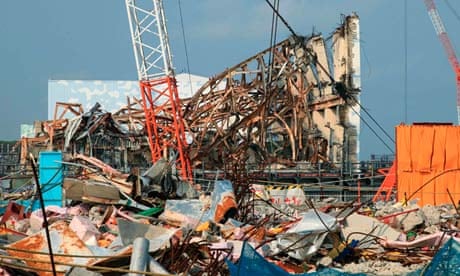The company at the centre of Japan's worst nuclear crisis has acknowledged for the first time that it could have avoided the disaster that crippled the Fukushima Daiichi power plant last year.
In a reversal of its insistence that nothing could have protected the plant against the earthquake and tsunami that killed almost 20,000 people on 11 March, Tokyo Electric Power (Tepco) said it had known safety improvements were needed before the disaster, but had failed to implement them.
"When looking back on the accident, the problem was that preparations were not made in advance," Tepco's internal reform taskforce, led by the firm's president, Naomi Hirose, said in a statement on Monday.
The company could have taken steps to prevent a catastrophic accident by adopting more extensive safety measures, the statement added.
Tepco's about-turn came after an independent panel of experts challenged its claim that it could not have foreseen the up to 14m high waves that swept through the plant, knocking out its backup power supply and causing three of its six reactors to melt down.
In a damning report released in July, a parliament-appointed panel criticised years of "collusion" between Tepco, industry regulators and politicians, and described the disaster as "manmade".
The crisis forced the evacuation of 150,000 residents, most of whom have yet to return home, and led Japan to announce it would end its reliance on nuclear energy, although it has since dropped its deadline to phase out atomic power by 2040.
In a rare moment of introspection, an internal taskforce set up to reform the embattled utility said the firm feared that improvements in safety would highlight the risks to nuclear power plants and encourage the anti-nuclear lobby.
"There was a worry that if the company were to implement a severe-accident response plan, it would spur anxiety throughout the country and in the communities near where nuclear plants are sited, and lend momentum to the anti-nuclear movement," the report said.
The firm conceded that some suggested safety improvements, such as using multiple power sources and cooling systems, would have required the plant's temporary closure and added to its costs. Acknowledging that previous safety measures were insufficient could have invited lawsuits, it added.
The statement said the company should have adhered more closely to international safety standards for atomic facilities, and trained specialist staff in practical disaster response rather than relying on safety drills it dismissed as a "formality".
Tepco's admission that it was unprepared for the disaster came after the first meeting of an independent advisory committee set up to help the company reform its nuclear operations.
"It is very clear that mistakes were made," Dale Klein, the former chairman of the US nuclear regulatory commission and head of the reform committee, told reporters in Tokyo.
"It is very important for Tepco to recognise the need to reform, and the committee is very anxious to facilitate the reform necessary for Tepco to become a world-class company.
"The committee's goal is to ensure that Tepco develops practices and procedures so an accident like this will never happen again."
Klein said individual workers at the plant would be expected to challenge the pervading culture of complacency over safety. "The challenge that Tepco will have is establishing a culture so that every individual understands they are responsible for safety," he said.
The report noted that Tepco had not made any safety improvements to the Fukushima Daiichi plant since 2002, and had dismissed the possibility of it being hit by a massive tsunami, even though it could not produce supporting data.
It had, for example, insisted that Fukushima Daiichi's 5.7m seawall was high enough to withstand a tsunami generated by a large quake in the area, despite a warning in 2008 by its own engineers that much bigger waves were possible.
Tepco repeated claims it had done everything possible to prevent a disaster as recently as July. Instead, it accused the prime minister at the time of the accident, Naoto Kan, of exacerbating the problem by interfering in the firm's response.
Tepco has been forced to reform its management and operations after the government saved it from collapse in May, in effect nationalising it with a 1tn-yen bailout.
Despite Japan's plan to phase out nuclear power, Tepco's 10-year business plan includes the need to restart idled reactors, beginning with those at its Kashiwazaki-Kariwa plant in northern Japan.
But the company denied its admission of culpability and efforts at reform were intended to mollify the public ahead of a quick return to nuclear power generation.
"The reforms are intended to improve our safety culture, and we have no intention to link it to the possibility of resuming the [Kashiwazaki-Kariwa] plant," Takafumi Anegawa, a Tepco official, told the Associated Press. "We don't have any preconditions for our reforms."
The firm's efforts to restart other reactors received a boost from Barbara Judge, the former chair of the UK atomic energy authority, who said nuclear plants could operate safely – even in quake-prone countries such as Japan – provided the right safety measures were in place.
"It's a question of determination of the risks. It's a question of making sure that there is a plan for how to deal with the risks, or the problem, should they eventuate," Judge said.




Comments (…)
Sign in or create your Guardian account to join the discussion